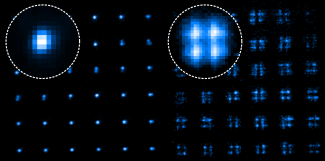Another appealing aspect of alkaline-earth atoms is the presence of a second relatively narrow transition — though not as narrow as the clock transition — that can be used for ground-state laser cooling. This is especially powerful when combined with the possibility of rearranging optical tweezers to prepare arbitrary atomic distributions with very low entropy in the atomic spatial distribution. So far, large-scale demonstrations of atomic rearrangement have been used for spin models, with atoms that might be relatively hot in their motional degrees of freedom. In this project, we seek to prepare arbitrary distributions of scalable arrays of ground-state atoms for large scale itinerant models. In particular, we wish to load cooled atomic tweezer arrays into an optical lattice potential, to prepare arbitrary initial conditions for Hubbard physics. In so doing, we can assemble bosonic or fermionic Hubbard systems with versatile initial conditions, fast cycle times, and potentially very low entropies, combining the preparation capabilities of tweezers with the single-particle detection accomplished with quantum gas microscopy. We envision this platform will be useful for studies of non-equilibrium dynamics, where large entanglement growth demands high statistics measurements, and for studies of quantum-optical phenomena like boson sampling.
In the picture above, we show single atoms loaded into a lattice and the resulting tunneling distribution, exhibiting a high degree of spatial coherence. This is the first step towards assembly of lattice Hubbard systems. We further envision that this research thrust can combine with the Rydberg dressing of the quantum metrology program to realize tunable extended-Hubbard models.



 The Physics Frontiers Centers (PFC) program supports university-based centers and institutes where the collective efforts of a larger group of individuals can enable transformational advances in the most promising research areas. The program is designed to foster major breakthroughs at the intellectual frontiers of physics by providing needed resources such as combinations of talents, skills, disciplines, and/or specialized infrastructure, not usually available to individual investigators or small groups, in an environment in which the collective efforts of the larger group can be shown to be seminal to promoting significant progress in the science and the education of students. PFCs also include creative, substantive activities aimed at enhancing education, broadening participation of traditionally underrepresented groups, and outreach to the scientific community and general public.
The Physics Frontiers Centers (PFC) program supports university-based centers and institutes where the collective efforts of a larger group of individuals can enable transformational advances in the most promising research areas. The program is designed to foster major breakthroughs at the intellectual frontiers of physics by providing needed resources such as combinations of talents, skills, disciplines, and/or specialized infrastructure, not usually available to individual investigators or small groups, in an environment in which the collective efforts of the larger group can be shown to be seminal to promoting significant progress in the science and the education of students. PFCs also include creative, substantive activities aimed at enhancing education, broadening participation of traditionally underrepresented groups, and outreach to the scientific community and general public.